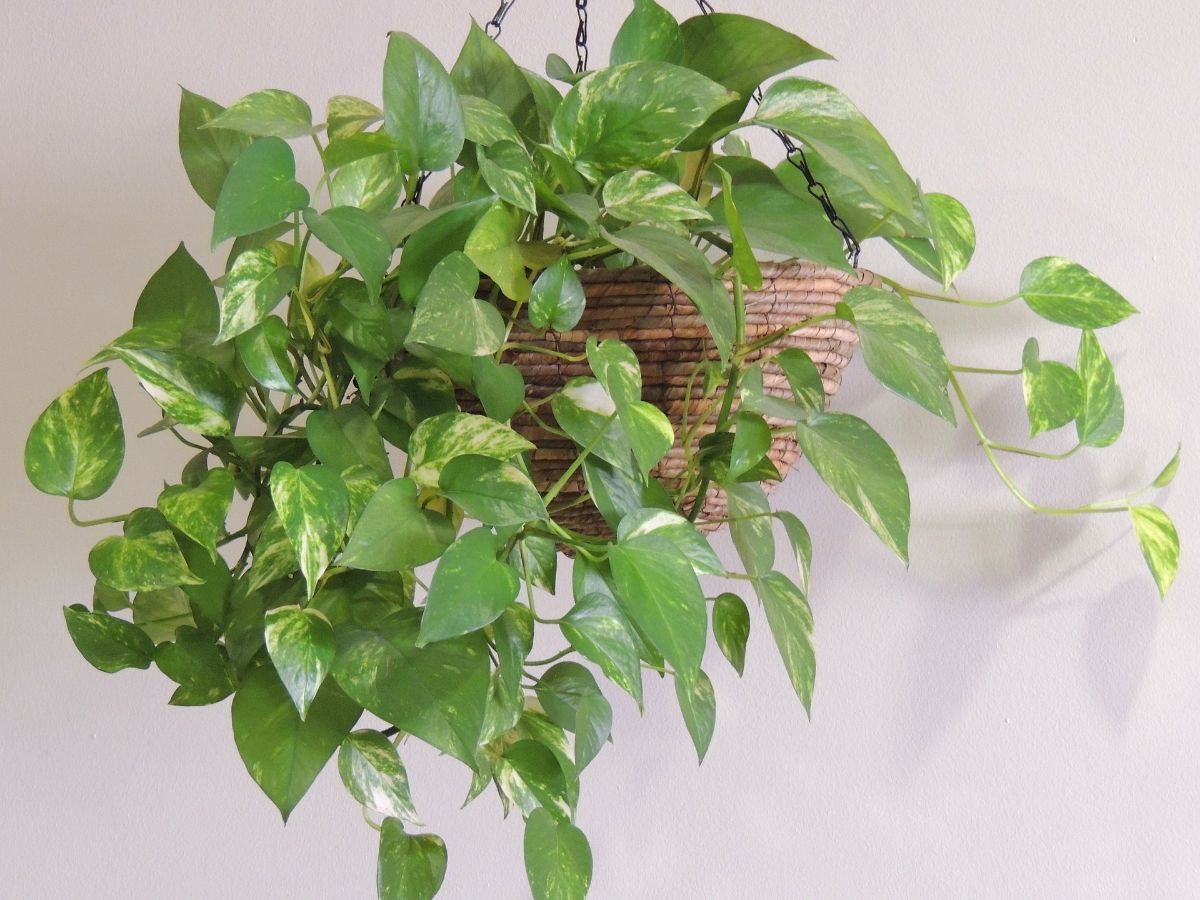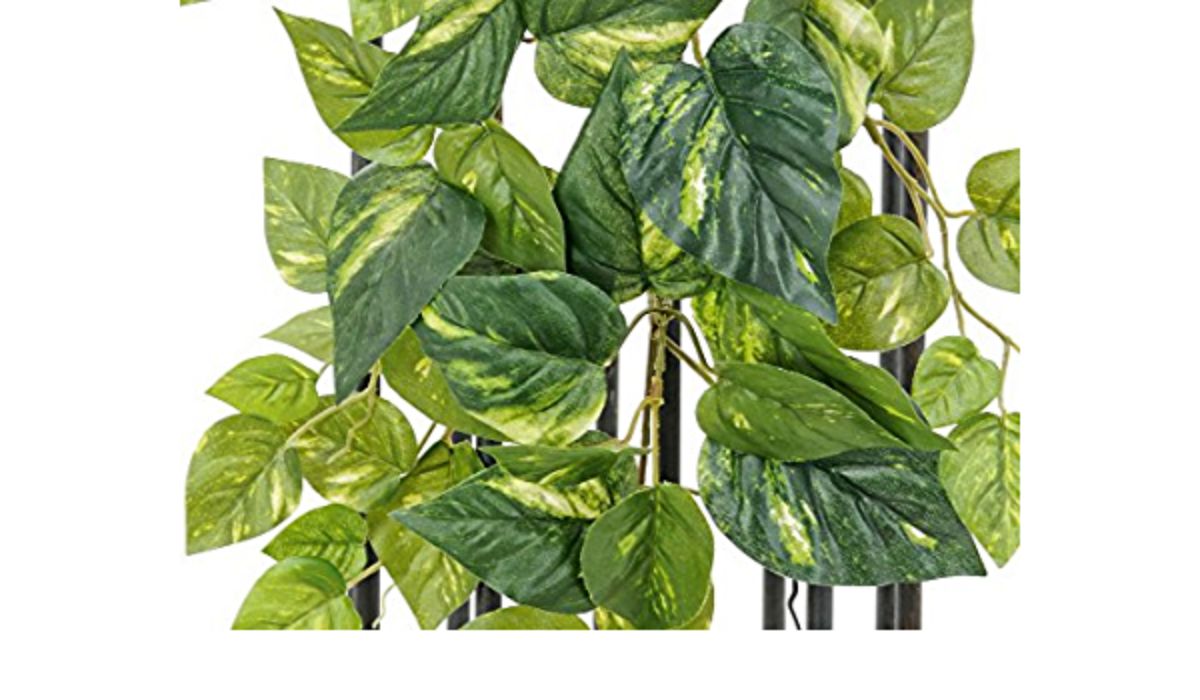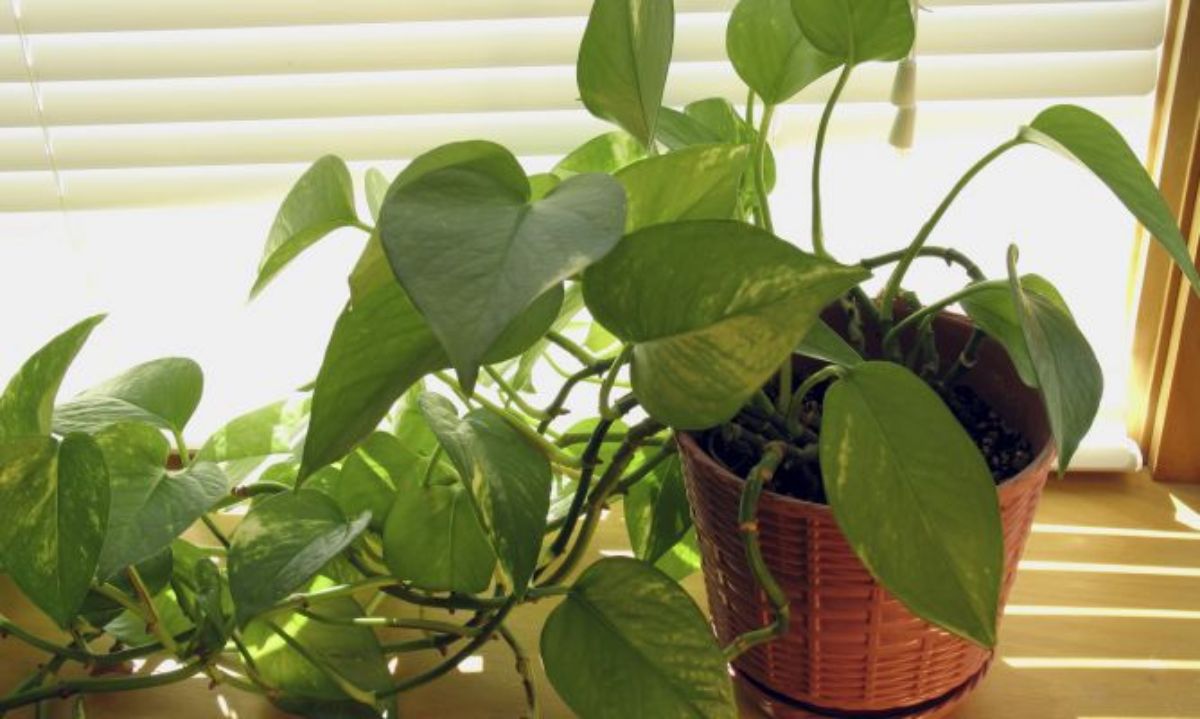
Do you have a poto at home? Have you grown a lot and now you are wondering how to prune a poto? Well, you have come to the right place because we are going to give you the complete guide on this specific care so that you know when to do it, how and some tricks that can come in handy.
Pothos in general are very easy plants to care for and pruning is one of the easiest to do, in addition to resisting strong pruning very well in case you go too far when doing it. But what are the keys to getting the best results?
When is a poto pruned?

A poto is one of the easiest plants to have at home. It is very rare for one to die (although it can happen) because they are very resistant. Normally they are placed inside the house and are characterized by climbing plants, which you can have hanging or vertically, depending on how you like it best.
Its predominant color is bright green, although you can find some shades of green or yellow that give it a unique look.
For that ease of adapting to any environment, poto is one of the plants that you have to prune to prevent it from "going out of its way." And it grows very fast and that allows you to play with it a little to get a vertical poto (through a tutor), whose leaves will be larger, or hanging, with smaller leaves.
The key that will tell you that the poto is ready for pruning is when the stems are long and weak. These are too big for the plant and take away a lot of its strength, so cutting them will be much better for the health of the plant. But when to prune a poto? At any time of year?
The easy answer is that At any time of year, more if we have told you that they grow fast; And although shoots or branches can be cut at any time, it is recommended that, when doing a good pruning of the poto, you wait until the vegetative season is over, that is, when the plant is less active. And when is that? Specifically in the months between mid-March and the end of September. Instead of doing it when the plant is "hibernating", in this case it is best to do it when it is more active, because this ensures that it will sprout and regain vigor very quickly.
Now, that does not mean that from October to March you cannot cut it; yes you can do it but it is not recommended to subject it to a large pruning, but only to maintenance.
How many times do you have to prune a poto
One of the common questions when it comes to pruning a pothos is not only knowing when, but how many times. And it is that, when you have a plant that grows very fast, continually cutting it sometimes makes you doubt if you are not "tiring" it. In other words, consuming it.
Note that, when you prune a plant, its energy goes to heal that wound and replenish what it has lost. So if it is pruned a lot, it can cause a problem in it.
In the case of poto, you may run into this problem. But you should know that it is not so dangerous, and besides you have a weapon with which to combat fatigue: manure or fertilizer.
You can prune the poto as many times as you want. It is advisable to leave a space of time between pruning and pruning to avoid problems. What we do recommend is that you hold on as long as possible and give it a little manure or liquid fertilizer from time to time to provide it with adequate nutrients and energy to recover.
If you notice that you have pruned your poto and suddenly it slows down or directly stops and does not grow, it may be because it needs more energy and in those cases it is recommended not to prune it, fertilize it and let time pass until the plant becomes active again.
You should also know that in winter it will grow much less than in spring or summer.
How do you prune a potus?

Now that you know when to prune a poto, it's time to find out how to prune a poto. And it is the simplest there is. In fact, we give you the keys, which will serve you both for a vertical one and for a hanging one.
Choose the longest stems
These stems further they must have the characteristics of being weak. Try to find which ones meet these requirements and, once found, with suitable scissors, always cut below the nodes of the branch.
Make sure that the tool you use gives it a clean cut and that, in addition, it is disinfected because this will prevent you from getting sick.
Clean the leaves from the stem
Once you have cut the branch, you have two options: either you throw it away, or you plant it. We always recommend the latter, because a new poto can be born from it, which you can have at home or give to your loved ones.
If you opt for this, you have to clean the leaves that are near that stem. Now, put it in a glass of water. Be careful to change this liquid every few days because you will have to wait for it to take root to be able to plant it in a pot.
Some what they do is plant it directly and keep the soil moistened. It is not a bad idea but it may take longer than if you use the glass of water.
Wait for roots to grow
Have roots already grown? Well then the last thing you should do is plant it, either in a new pot or in the one you had, so that it shares space with the mother plant.
How to make a leafy poto?
Do you remember that we told you to plant what you have pruned with the mother plant? This is the trick that many use to make a leafy poto.
What they do is cut branches, wait for roots to emerge and place them around the original plant so that it acquires a condition of being more leafy than it is.
The reason why a poto is looking less leafy is because, as it grows, the stem is as if it became a trunk, and that causes it to lose leaves in that area. On the other hand, by placing stems of the plant itself there, this is hidden and you give it back that aspect that you are looking for.
How to prune a vertical poto?
In the event that you have a vertical poto, when they grow what they do is that they lose their shape, be it round, oval, etc. To prune a vertical poto it is convenient that keep that shape, so that you should cut the branches that stick out.
If you want, because the poto is growing, so that it is not so devoid of leaves at the bottom, what you can do is plant those stems at the base (once they have roots) to hide it, and once they start to grow, you are making it entangle itself on the mother plant.
When not to prune a potho
Another important point to keep in mind when pruning a potho is to know if it can be done or not. And there are situations in which pruning is not recommended, since it will have a devastating effect on the plant and could even kill it.
Among the situations in which it is not recommended are:
Winter
Not only in winter, but in times of very cold, frost... It is true that they coincide with winter, but they could also arrive in spring or autumn.
The reason why they are not recommended is because, by cutting stems, you are exposing internal parts of the plant and the cold, as well as other "bugs" could enter and negatively affect its health.
In addition, you have to dedicate energy to heal that cut and this can weaken it and not last long enough until the good temperatures return.
Disease
Here we must specify a little. And it is that if the poto is affected by a plague and this must be eliminated by cutting the damaged branches, we must do it.
But overall, when a poto is sick, weak, etc. It is not advisable, in any way, to prune it, because it will not have enough energy to heal and all we will do is shorten the life of the plant even more (or prevent it from being able to recover).
In summer
Yes, the summer, the heat, is ideal for pothos because they grow very quickly. But In the midst of a wave of color, bringing the scissors closer to the plant is the worst thing you should do. It is better to wait a while for somewhat milder temperatures to arrive and cut very little by little so as not to weaken it too much.
Pincer poto: when and how?

Source: homemania
In case you don't know, clamping is nothing more than cutting the new leaves that come out of a bud. This is done with the hands, specifically, with the thumb and forefinger, and serves for a more compact growth.
In the case of pinching a poto, what it would consist of is removing the first couple of leaves from a stem, as if you were cutting a tender twig, using your hands, although you can also use scissors or a knife. Of course, we recommend that you do it when the branch is at least 15 centimeters, unless your poto is very dense (if so, wait until it has branches of 5-8 cm).
How to make a tutor for poto?
Do you want to turn a hanging poto into a vertical one? Maybe the tutor I had is broken and you need another one? Don't worry, you don't actually have to spend money to buy a new one, you can do it at home very easily.
All you need is a cane pole, the height you need, a piece of plastic mesh (for example mosquito nets), at least 30 centimeters wide and the height of the pole you have; dry leaves and a little dirt.
What it is about is that you place the extended mesh and, at one end of it, put the stick and some soil and dry leaves. Now, you have to roll the mesh in such a way that you will have a curler. Take some wires, rope or similar and tie everything so that it does not come loose and it will be ready for you to nail it into the plant.
Then you just have to help the plant to wrap itself around this tutor and it will start to grow around it.
How to have a hanging pothos
As you know, the poto can be placed with a stake in which the plant is wound, or in a basket hung on a wall, ceiling, etc. If you want to achieve this, then here are some keys:
- Let it grow almost at will. When you want it to hang, you will need the branches to hang down to make it more beautiful. Now, it is possible that it only has one area, and not all, so it is best to let it grow and then "adapt" it.
- When you have the desired height, allow several more centimeters. The goal is to grow a little more and then prune that extra part. And it is that with it you could plant it in the pot, in the most "bald" areas or where you need the plant to develop, and thus cover the entire pot with them.
- Take care that it gets good light and that it breathes. Because if the pot is going to be leaning against a wall, the part that hits it will not be able to develop well, and that must be foreseen.
In reality, there are not many more tricks to getting a hanging pothos other than arming yourself with patience and letting the plant develop its stems and drop them. It all depends on how long you want them.
How to use the poto to decorate
Potho is one of the favorite plants for many. Not only for its beauty, but also for the decoration it offers in houses. In fact, here are some ideas to decorate with it.
at the entrance of your house
In this case, our recommendation is that you have it vertically, since it will dress the entrance much better than if it were hanging. Besides, it could be more annoying that way.
Ideally put it in a corner, so if you use a corner or square pot it will be better.
Another option, especially if it is small, is to put it on a piece of furniture in the entrance.
In the lounge
On a shelf vertically on a part of the wall, or even hanging near a window could be great.
What many do is put it near the television to have something "natural" to watch.
In the kitchen
Because if you put it hanging it will be very showy. Of course, be careful with placing it in an area where you pass a lot because it could hinder your passage.
Some what they do is put it on top of the furniture and direct its branches so that these do not prevent opening the doors.
In the bathroom
If your bathroom has a window, you could place it there, either on a shelf or hanging. The important is that have some light otherwise the leaves will all turn green and that's not what you want.
In your bedroom
In case you don't know, the potho is a purifying plant, which will make toxins in the atmosphere are removed. So it is not unreasonable to have one in your room.
In fact you can put it on a small table and direct the branches over the headboard. Or place it on a top shelf and put it there to cascade down.
As you can see, learning how to prune a poto is very simple, as well as all the activities that this activity would include. Do you dare to do it with your plant? Don't be afraid, you sure won't kill her.